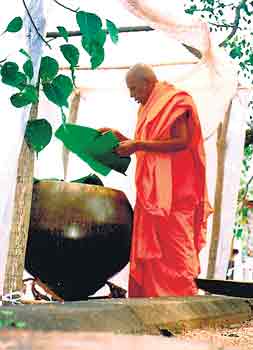
Rice rituals going back to ancient daysCertain rites and rituals observed from the time of the ancient kings and connected with important festivals like the Avurudu, are still very much alive at least in four villages in Kandy. The ancient monarchs believed that a village would only prosper if its people were united through activities centred around the village temple. Around 12 km from Kandy one comes to the Sagama Raja Maha Vihare dating back to the period of King Devanampiyatissa. Planted here is one of the eight Bo-saplings that were propagated from the sapling that Sanghamittha Therani brought to Sri Lanka.
Every year, the Sri Dalada Maligawa distributes 'new' rice to the Raja Maha Vihares for these temples to have their own 'Alut Sal' Mangalaya (festivity connected with the harvest) . According to the incumbent of the Sagama Raja Maha Vihare, Ven. Ampitiya Dharmapala Thera during ancient times the rice distributed by the Maligawa was brought in procession to the respective Raja Maha Vihares but today the 'Alut Sal" is brought in a vehicle. About three days after the Sinhala New Year, the villages of Godamunne and Kapuliyadde get busy with rituals connected with the Sagama Raja Maha Vihare. The rituals start off with bringing about half the quantity of rice, that has now been distributed from the Sri Dalada Maligawa to the Sagama Raja Maha Vihare, to the respective villages. The villagers who have just concluded reaping a harvest, will cook this rice brought from the Raja Maha Vihare and offer it to both Lord Buddha and God Saman in the temple. It is not known why God Saman usually associated with the Sabaragamuwa Province is also a deity at Sagama Raja Maha Vihare, which is in the Central Province. Once the rice is cooked it is taken in a procession, called “Mal Perahera” to the temple. In addition to these two villages two others Bootawatta and Nugaliyada also make their way in procession to make their offering to the Sagama Raja Maha Vihare. On the sixth day, all the villagers gather at the Preaching Hall or Bana Maduwa of the temple and pound paddy. Only men take part in this ritual, known as "Hamba Ketuma". The pounding of paddy is done in a special wooden boat-like contraption by a group of about five or six men. The same night the villagers, once again men only, start cooking other food items. The following day, they fill the cooked rice and other foods into two large bowls and they are taken to the Vihare and offered to Lord Buddha and God Saman. This whole process is divided among the four villages, with two villages doing it for one week and the other two continuing the process the following week. This ceremony would have been practised in most villages in the Kandyan Kingdom, but today it is found only in these four villages. |
|
||||||
|| Front
Page | News | Editorial | Columns | Sports | Plus | Financial
Times | International | Mirror | TV
Times | Funday
Times || |
| |
Reproduction of articles permitted when used without any alterations to contents and a link to the source page.
|
© Copyright
2008 | Wijeya
Newspapers Ltd.Colombo. Sri Lanka. All Rights Reserved. |
